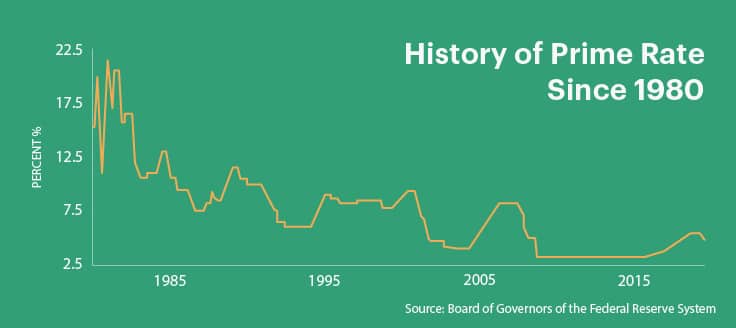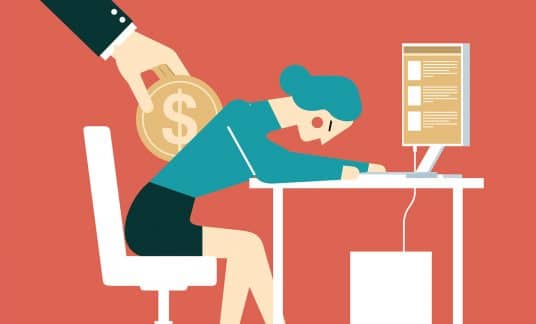The current prime lending rate is at 7.5%, as of December 2022. Let’s look at the ins and outs of prime rates so you have a better understanding of what it means when you’re looking to fund your business endeavors.
What Is the Prime Rate? A Definition
The prime rate, or prime lending rate, is the best interest rate financial institutions offer the most creditworthy customers, known as prime borrowers. These are customers with years in business, dependable income and high credit scores.
The prime rate is the base rate for most commercial loan products, upon which lenders typically charge a premium based on the riskiness of a borrower.
Prime borrowers sometimes qualify for the prime rate, although other variables can impact the loan decision.
Banks and other lenders use the national prime rate as a starting point on interest rates for the following:
- Loans
- Lines of credit
- Credit cards
- Business mortgages
- Business loans
- Vehicle loans
- Home mortgages
Based on the riskiness of a particular borrower, lenders add some amount of margin over prime rate when they offer to make a loan. The higher the risk, the higher the margin.
How Prime Rate Is Calculated
The prime rate is calculated using the federal funds rate. That’s the interest rate commercial banks charge each other for overnight lending. It’s set by the Federal Open Market Committee (FOMC), a group within the Federal Reserve System, which meets regularly throughout the year.
The prime rate isn’t determined by the U.S. government, though. Instead, banks set the prime rate. While banks can make independent decisions and set their own rates, most add a standard percentage to the federal funds rate to calculate their prime lending rate.
Prime Lending Rate History
The prime rate exceeded 20% in the early 1980s but has been lower since then. In response to the economic downturn of 2008, the prime rate was lowered to the lowest it had been in more than 50 years, 3.25%. Since then, it has experienced ups and downs, with the current prime rate raised several times in 2022 alone, to 3.5%, then 4%, then 4.75%, then 5.5%, to 6.25%, to 7% the most recent rate of 7.5%.
The Federal Reserve lowers or raises the federal fund rate amid changes to the U.S. economy. When there’s a change to the federal funds rate, most banks adjust their prime lending rates quickly in response.
When the federal fund rate goes up, it leads to a prime rate increase. That means higher rates for loans and higher costs for consumer and business borrowers. Even small upticks in rates can impact loan amounts. While fixed-rate loans aren’t affected, variable rate loans are sensitive to federal rate hikes and can change quickly.
Fixed rates have locked-in rates for the term of the loan. That means no changes during the term. As such, the prime rate only impacts the loan when it’s originated.
For variable rate loans, such as variable lines of credit, the rate can rise immediately. That means a higher cost over the life of the loan and an almost immediate increase in the monthly payments you will need to make.
-
A Prime Rate Example
Let’s say you have a variable small business loan of $100,000 with a 5-year term at 10%.
A half-point increase in the loan rate can mean an additional $2,500 ($100,000 x 0.5% x 5 years = $2,500) out of your pocket over the life of the loan.
Typically, rising rates also lead to higher rates on business credit cards. Additionally, if you tend to carry a balance, the amounts you aren’t able to pay off get more expensive.
If you have business savings, there can be a positive effect. Although deposit and savings rates don’t increase at the same pace as the prime rate, savings rates often increase after the prime rate rises.
Why Do Prime Rates Change?
When the prime rate is low, it spurs borrowing and stimulates the economy. The opposite is true as well. Increases to prime rate make it more difficult for businesses – especially small businesses – to afford the cost of loans.
The Fed tends to lower interest rates when unemployment is high or the U.S. economy is sluggish. That reduces the prime rate banks set and encourages lending and investment.
When the economy is going strong and inflation is expected to rise, the federal fund rate is raised. The prime rate goes up as well. The theory is the increased rate helps to keep prices and spending under control.
What Rate Above Prime Will Your Business Get?
Any time a business takes out a loan, the lender runs the risk that the borrower will not pay it back. To compensate for this risk, lenders charge interest. The better credit risk you are, the closer your rate will be to prime.
When taking out a loan for your business, there are a variety of factors that can impact the rate you get. While you always want the lowest rate possible, you may not qualify for prime financing rates if lenders have concerns about your credit score. They’ll examine how long you’ve been in business, too.
Depending on the business you’re in, rates may vary. If your industry has a higher-than-average default rate, you may be negatively impacted no matter how strong your business performs. Demonstrating you have a solid business plan for future growth can help.
Simply put, the lower the risk for the lender, the better the deal you’re likely to get.












